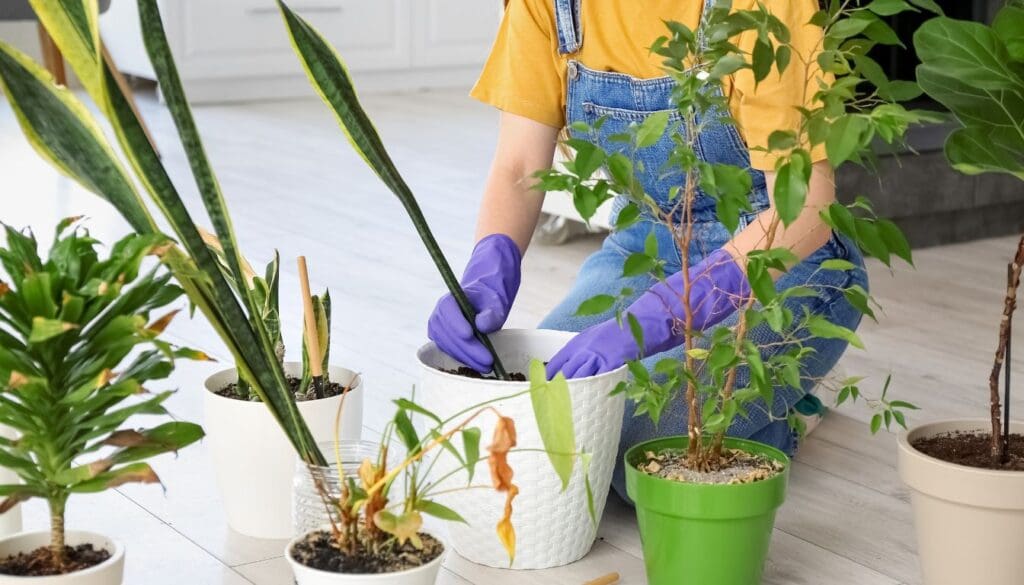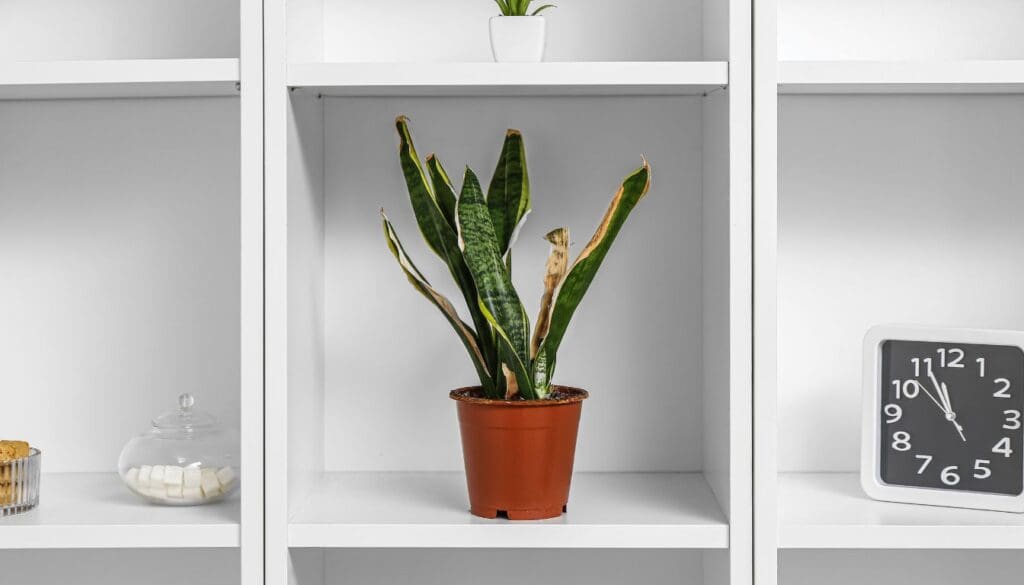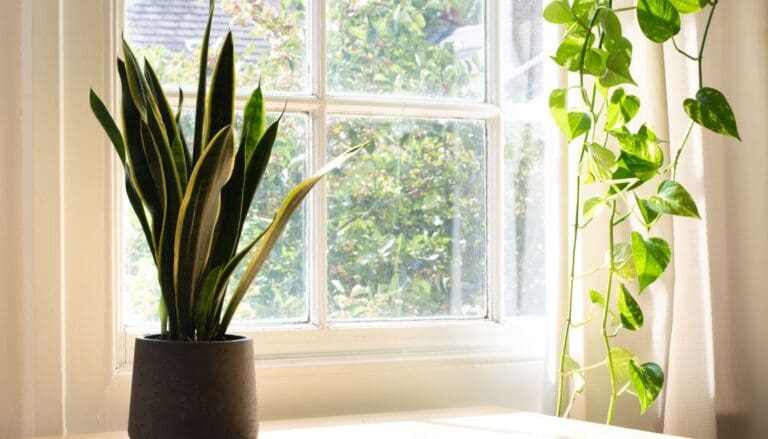10 Common Snake Plant Problems & How To Fix Them!
Got a snake plant that’s not feeling its best? 🌿 You’re not alone.
Snake plants are usually easy to care for, but sometimes they face common problems that can be puzzling.
I’m here to help you keep your plant happy and healthy.
Have you noticed your snake plant looking a little off lately?
From droopy leaves to picky watering needs, there are a few things that might need your attention.
Let’s explore these common issues together and find simple solutions.🔍👍

Please note: Simplify Plants is reader-supported. As an Amazon Associate, I earn from qualifying purchases made by our readers with no extra cost added to you all! Some links in the post are affiliate links and I get a commission from purchases made through links in the post.
1) Overwatering Issues & Solutions
Snake plants can usually handle a bit of neglect.
Overwatering is a common problem, though. When I notice yellow leaves and mushy roots, I know I’ve given my plant too much love. Does this sound familiar? 😅
To fix this, I start by checking the soil. If it’s soggy, I know I’ve overdone it.
I stop watering immediately and let the soil dry out completely. Sometimes, I even remove the plant from the pot to speed up the drying process.
Good drainage is key. I always make sure my snake plant is in a pot with drainage holes. This helps excess water to escape, preventing further sogginess. Do you have drainage holes in your pot? 🪴
Next, I think about my watering schedule. Maybe I was too eager, watering every week. Snake plants don’t need that much.
I remind myself to water only when the top inch of soil feels dry. This simple trick helps me avoid future overwatering mishaps.
It’s also a good idea to use a well-draining soil mix. I like to mix regular potting soil with some sand or perlite. Does that sound like something you can try? Let me know! 🌱
Remember, more water doesn’t equal more love.
Snake plants thrive on a laid-back approach. So, take it easy and watch them grow happy and healthy! 🪴😊
2) Root Rot Prevention Tips
Ever hear about root rot and wonder if your snake plant is at risk? 🤔 Let’s make sure it stays healthy!
Root rot happens when the roots sit in too much water.
I keep my snake plant’s soil dry between waterings. This prevents soggy roots. Do you wait until the soil feels dry before watering?
I also make sure the pot has drainage holes. Good drainage lets excess water escape, keeping the roots safe. If the pot doesn’t have holes, I drill some! Do you have a pot with drainage? 🪴
Another tip is to use a well-draining soil mix. I mix in some sand or perlite to help with this. It allows air to circulate around the roots. Have you tried a different soil mix for your snake plant?
If your snake plant is indoors, make sure it’s not in a dark spot. Low light keeps the soil from drying quickly.
I place mine in bright, indirect light. Where do you keep yours? ☀️
Fertilizing can also help, but I make sure not to overdo it. Too much fertilizer can harm the roots.
I stick to a balanced fertilizer and use it sparingly. Are you careful with your fertilizing routine?
By following these simple steps, my snake plant thrives, and root rot stays away. If you’ve got other tips, I’d love to hear them! 🌿
3) Dealing With Pest Infestations
Do you love your snake plant but hate the pests trying to move in? I feel you! Let’s get rid of these unwanted guests. 🕷️
Spider mites are sneaky little critters that can mess with your plant. If you see tiny brown dots and webbing, you’ve got them.
I like to use a mix of water and mild dish soap to spray down the leaves. It’s an easy DIY fix!
Next up, mealybugs—those fuzzy white pests that love to hide.
I sometimes wipe them off with a cotton swab dipped in alcohol. It’s oddly satisfying! Plus, it keeps my plants healthy.
Don’t forget about fungus gnats. If the soil stays too damp, these guys might pop up.
To fix this, I let the soil dry out between waterings. Who knew that giving my watering can a break could help so much?
Are you dealing with pests right now? What’s bugging your plant? 😜 Let me know! Sometimes, sharing tips makes all the difference. We’ve got this! 🌱👍
Have you ever used neem oil?
It’s a natural insecticide and works great for many pests. Whenever I suspect an outbreak, I give it a shot.
Plus, it’s safe for my pets—peace of mind for me and my fur babies! 🐾
Remember, a clean snake plant is a happy one. Keep those leaves dusted, and you’ll reduce pest problems. 👏
I try to make it a routine chore. It gives me time to admire my greenery! 🌿
4) Poor Drainage & Remedies

Ever noticed your snake plant looking sad and droopy? 😟 One common culprit is poor drainage!
Snake plants hate having “wet feet.” If the water can’t escape, your plant’s roots might rot, causing the leaves to droop or even die.
When I first dealt with this issue, I looked at my pot. Is the pot missing drainage holes? If so, it’s time to get one with proper holes. Think of it like giving your plant some stylish new shoes! 👠
Maybe your pot has holes, but the water is still sitting there. What’s up with that?
The soil might be too dense. Loosening the soil can be a game-changer.
I mix my soil with a bit of sand or perlite to boost drainage. This keeps the roots happy and healthy.
Do you let excess water sit in the saucer beneath the pot?
I learned this the hard way once! Unused water shouldn’t become a swimming pool for plant roots. 🏊♀️
Next time you water, observe how quickly the soil drains.
Take charge and keep those roots dry. Your snake plant will thank you with greener, perkier leaves. 🌿 Who doesn’t love a happy plant?
5) Repotting Stress Solutions
Ah, the joy of repotting! 🪴 It can be exciting for me and my snake plant. But sometimes, my plant feels stressed during the big move.
I usually see signs like wilting or yellow leaves. Does your snake plant do that too? It’s like it’s saying, “Why did you move me?”
To help, I make sure not to go up more than one pot size. Too much space can overwhelm my plant, making it feel lost in its new home.
I always use fresh, well-draining soil. This gives my plant a fresh start and helps avoid soggy roots. Nobody likes wet feet, not even plants!
After repotting, I give my plant some time to adjust. I keep it in the same light conditions it’s used to. A little bit of TLC goes a long way.
Watering less for the first week also helps. I let my plant settle in before giving it a drink. too much water too soon can stress it out. 💦
I sometimes use a natural plant tonic to help with stress. Just a little boost to make it feel better. Think of it as a spa day for my plant!
If you’re repotting soon, keep these tips in mind. Have you given your snake plant a new home yet? Let me know how it goes! 🌱
6) Yellowing Leaves Causes & Fixes

Ever looked at your snake plant and noticed those yellowing leaves? I have, and it’s like my plant is waving a yellow flag! 🌿
Check for overwatering first. Too much water can drown the roots, making the leaves turn yellow.
I keep the watering light, letting the soil dry out between sips.
Is your plant sitting in a dark corner? Lack of light is another culprit.
I move mine to a bright spot, but not in direct sunlight. This helps them soak up just enough light without getting sunburned.
Sometimes, pests love my snake plant as much as I do. 🐜
Tiny bugs might be munching on it, causing yellow spots.
I gently wipe the leaves with a damp cloth and use a mild soap spray to keep those critters away.
Check the potting soil. Nutrient-deficient soil can starve the plant, turning leaves yellow.
I refresh the soil mix now and then, adding a bit of fertilizer during growing months to keep my plant happy and green.
Temperature swings can be tough. Too hot or too cold leaves my plant upset and yellowing.
I try to keep my home within the comfortable room temperature range. 🌡️
Have you had a snake plant with yellowing leaves? What worked for you? Let’s chat about it! 💬
7) Low Light Adaptation Tips
Snake plants are like the superheroes of houseplants. They can tolerate low light, but they might not be thrilled about it. ⭐️
Do you have a dim corner where other plants just quit? It might be a challenge, but with some care, your snake plant can still thrive.
First, let’s talk rotating. 🌿
I try to rotate my snake plant every few weeks. This way, each side gets a fair shot at whatever light there is. It’s like a mini vacation for its leaves!
Keep in mind, water less often. In low light, snake plants need less water.
I check my plant’s soil and only water when it’s dry a couple of inches down. Overwatering can be more harmful than a little bit of thirst!
I also dust the leaves regularly. Clean leaves can use what little light there is more efficiently.
A simple wipe with a damp cloth does the trick. 🧽 Sometimes, I even chat with my plant while doing this!
Ever tried moving your plant temporarily? 💡
I sometimes place mine in a brighter spot for a day or two, then move it back. It’s like giving it a little sunlight spa getaway!
It’s always fun to experiment with different locations in the room. Maybe a shelf, maybe a corner by the window. I like seeing how my plant responds to these small changes.
Does your snake plant have a low light battle story? Share with me! 🌱🌈
8) Correct Soil Mix Recommendations

Choosing the right soil mix for a snake plant can make a huge difference in its growth.
Snake plants love well-draining soil. This is key because too much water can actually hurt them! Ever tried to water your plant only to see it droop? Yep, wrong soil might be the culprit. 🌱
I often use a blend of two parts of regular potting soil and one part of sand or perlite.
The sand or perlite keeps things airy, so water doesn’t hang around too long. This mix helps in preventing root rot, which snake plants are prone to if left in soggy soil.
Got any cacti or succulents? Their soil mixes work well for snake plants, too! They’re designed to drain fast. It’s a win-win.
By the way, do you ever find yourself wondering why these plants have cat-like resilience? They just don’t want much water.
Experimenting with soil can be fun! Just remember, stick to light and chunky soil. Avoid heavy, dense soil. Your snake plant will thank you.
In case you didn’t know, adding a bit of organization in a plant’s pot can be fun, like pebbles at the bottom! Adds to the drainage and looks cute, too.😁
How’s your snake plant doing these days? Drop a comment and let me know if these tips worked. I’d love to hear from you! 🌿
9) Brown Tips & Reasons

Have you noticed those pesky brown tips on your snake plant? 🪴 It’s a pretty common problem, and I’m here to help!
Lack of Water could be one reason. If your snake plant looks thirsty, try giving it a drink. Just don’t overdo it!
Snake plants like their soil to dry out between waterings. Check the top inch of soil to see if it’s dry before watering.
Another reason could be low humidity. Is the air in your home as dry as the Sahara?
You might want to move your plant to a more humid spot. You could also try placing a bowl of water nearby or misting the plant lightly.
If your plant is getting too much sun, that can also be a reason. Bright, indirect light works best.
Are your plant’s leaves sunbathing for too long? Try moving it a bit farther from the window.
Fertilizer burn happens if I’m too generous with feeding. Too much fertilizer can scorch the tips!
I make sure to follow the recommended amounts, usually sticking to a schedule of once a month during the growing season.
Maybe your soil’s not cut out for it. Snake plants aren’t too picky, but if the soil can’t drain well, brown tips might appear.
I often look for a well-draining soil mix to plant in.
Ever wondered if drafts are enemies of your plant? Snake plants hate cold drafts!
I keep mine away from windows and doors that let in chilly air.
It’s interesting how different factors can leave your plant with brown-tipped leaves.
Have a trick that helps your snake plant? ⛅️
10) Temperature Stress Effects
Have you ever felt too hot or too cold? Well, snake plants feel it too! Extreme temperatures can stress these plants out.
If it gets too cold, like below 50°F, they might become weak and droopy. And if it’s too hot, they can dry out faster than you can say “water me”! 🌞❄️
Have you noticed brown tips on your snake plant? This can be a sign of temperature stress.
When temperatures swing wildly, the plant might struggle. It’s like wearing a winter coat in summer—you wouldn’t like it either, right?
Try not to place your snake plant next to a drafty window or a heater.
Keep them at a comfy room temperature, about 60-75°F. They don’t like big changes in temperature, just like us!
Do you ever wonder where to place them during those chilling winter nights?
If your plant is by a window, the temperature can drop quickly. Move them away from cold drafts and keep them nice and cozy. 😊
I like to think of snake plants as warm-blooded—they thrive when they aren’t freezing or boiling.
The key is to find a happy medium. By ensuring they feel comfy, you’re giving them the best chance to flourish.
Understanding Snake Plant Needs
Snake plants are easy to care for, but they still have specific needs to thrive. Let’s take a look at their light and water requirements to help them grow their best. 🌱
Light Requirements
I’ve learned that snake plants are quite adaptable to different light conditions. They can handle low light areas, but they really love bright, indirect light.
Putting your snake plant near a window with sheer curtains is ideal. 🌞
If you only have dim corners in your house, don’t worry! They’ll survive.
Still, I’ve noticed they grow healthier and faster when they get better light. Avoid direct sunlight because it can scorch the leaves.
Have any of you put your snake plant in a tricky spot? What was your experience? 😊 Share your story in the comments!
Watering Needs
Watering snake plants can be tricky at first. I figured that less is more.
You don’t need to water them often—only when the soil is completely dry. Overwatering is a common mistake that leads to root rot. So, be careful!
In the winter, I let my snake plant rest by watering it even less.
When I do water, I make sure to soak it well, then let it dry out completely. Easy-peasy, right?
Ever find yourself with an over-watered plant? It happens to the best of us! 🌿 Let’s swap stories below!
Identifying Common Snake Plant Problems

Snake plants are pretty tough, but they can still face a few issues. It’s important to spot the signs early so you can keep them healthy and happy. Let’s go over some common problems and how to identify them.
Leaf Discoloration
Have you ever noticed your snake plant leaves losing their color? It happens. 🙄
Yellowing leaves often mean overwatering. Snake plants like their soil dry, so soggy isn’t their style.
When you see brown tips, it’s like your plant is saying, “Hey, I’m thirsty!” That usually means it’s too dry.
Then there’s a pale or white appearance which might mean it’s not getting enough sunlight.
Keep your plant in bright, indirect light to keep those leaves vibrant. Remember, direct sunlight for too long can cause sunburn. No one likes a crispy plant!
Always listen to what your plant is telling you through its leaves.
Root Rot Concerns
Root rot is a sneaky problem that can hit snake plants hard. It’s caused by too much moisture around the roots.
If you’ve ever pulled your plant out and the roots look mushy or smell gross, that’s root rot.
Drainage is key, so make sure your pot has holes. ⛏️
I once used the “unwrap and dry” method to save my snake plant. Air out those roots!
If they’re too damaged, trim the rotten parts away. Healthy roots are firm and white, not brown and mushy.
Keep your snake plant’s roots happy by letting the soil dry out between waterings.
Have you ever rescued a plant from root rot? Let’s hear those plant-saver stories! 🌱✨
Frequently Asked Questions
Dealing with snake plant troubles can be confusing. Don’t worry, I’ve got some straightforward tips for the common problems you might face. Let’s dive in and keep those plants happy and thriving! 🌱
Why are the leaves of my snake plant turning yellow and crispy?
Yellow and crispy leaves often mean the plant is getting too much sun or not enough water.
Imagine sitting under a scorching sun all day without sunscreen—ouch! Move it to a spot with indirect light and check if it needs a drink. ☀️💧
How can I tell if my snake plant has been overwatered?
If your snake plant looks soggy or if the leaves are droopy, it might be overwatered.
Feel the soil: if it’s mushy, it’s time to let it dry out. Think of it like wearing soaked socks… not fun, right? Let that soil have a breather. 🧦💦
What are the signs of common diseases in snake plants?
Look out for signs like moldy patches, spots on leaves, or a stinky smell from the soil.
Just like us, plants can feel under the weather too. Keep an eye on these symptoms and make sure the plant is in a well-ventilated spot. 🩺🌿
How do I treat a snake plant with brown and crispy leaves?
Cut off the brown, crispy parts gently with clean scissors. It’s like giving your snake plant a haircut!
Check if it’s comfy—not too hot or cold, and water when the soil feels completely dry. ✂️💇♂️
What should I do if I believe my snake plant is sick?
If your snake plant looks pale or limp, try adjusting its environment.
Is it too wet or too dry? Maybe pests are lurking. I suggest moving it to a sunnier spot and keeping a watchful eye like a detective on a mission. 🕵️♂️🔍
How can I prevent common snake plant problems when growing them indoors?
Keep the soil slightly dry and ensure the pot has good drainage.
Think of it like wearing your favorite shoes—you don’t want soggy socks!
Good lighting and regular inspections can help prevent issues before they start.
Let’s keep these green buddies healthy! 🍀🏠
Recommended Garden Supplies
| Product Image | Our Recommended Gardening Supplies | Check Offers! |
|---|---|---|
Top Top
Top
Top
Top
Top
Top
Top
Top | rePotme Houseplant and Tropical Classic Potting Soil Mix | Check Offer On Amazon |
 Top
Top
Top
Top
Top
Top
Top
Top | Espoma Organic Indoor Plant Food | Check Offer On Amazon |
 Top
Top
Top
Top
Top
Top
Top
Top | GooingTop LED Grow Light 6000K Full Spectrum Clip Plant Growing Lamp | Check Offer On Amazon |
 Top
Top
Top
Top
Top
Top
Top
Top | Soil Moisture Meter | Check Offer On Amazon |
 Top
Top
Top
Top
Top
Top
Top
Top | Govee Hygrometer Thermometer, Bluetooth Enabled! | Check Offer On Amazon |
 Top
Top | LEVOIT Humidifiers for Large Room(Best For Plants) | Check Offer On Amazon |
 Top
Top
Top
Top
Top
Top
Top
Top | Upgraded DIY Automatic Drip Irrigation Kit, 15 Potted Houseplants Support | Check Offer On Amazon |
 Top
Top
Top
Top
Top
Top
Top
Top | Stainless Steel Heavy Duty Gardening Tool Set | Check Offer On Amazon |
 Top
Top
Top
Top
Top
Top
Top
Top | Bonide Insecticidal Soap | Check Offer On Amazon |
 Top
Top
Top
Top
Top
Top
Top
Top | Bonide 32 oz Spray Neem Oil for Organic Gardening | Check Offer On Amazon |
 Top
Top
Top
Top
Top
Top
Top
Top | Garden Safe Fungicide | Check Offer On Amazon |







